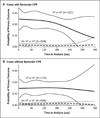Early versus later rhythm analysis in patients with out-of-hospital cardiac arrest
- PMID: 21879896
- PMCID: PMC3181067
- DOI: 10.1056/NEJMoa1010076
Early versus later rhythm analysis in patients with out-of-hospital cardiac arrest
Abstract
Background: In a departure from the previous strategy of immediate defibrillation, the 2005 resuscitation guidelines from the American Heart Association-International Liaison Committee on Resuscitation suggested that emergency medical service (EMS) personnel could provide 2 minutes of cardiopulmonary resuscitation (CPR) before the first analysis of cardiac rhythm. We compared the strategy of a brief period of CPR with early analysis of rhythm with the strategy of a longer period of CPR with delayed analysis of rhythm.
Methods: We conducted a cluster-randomized trial involving adults with out-of-hospital cardiac arrest at 10 Resuscitation Outcomes Consortium sites in the United States and Canada. Patients in the early-analysis group were assigned to receive 30 to 60 seconds of EMS-administered CPR and those in the later-analysis group were assigned to receive 180 seconds of CPR, before the initial electrocardiographic analysis. The primary outcome was survival to hospital discharge with satisfactory functional status (a modified Rankin scale score of ≤3, on a scale of 0 to 6, with higher scores indicating greater disability).
Results: We included 9933 patients, of whom 5290 were assigned to early analysis of cardiac rhythm and 4643 to later analysis. A total of 273 patients (5.9%) in the later-analysis group and 310 patients (5.9%) in the early-analysis group met the criteria for the primary outcome, with a cluster-adjusted difference of -0.2 percentage points (95% confidence interval, -1.1 to 0.7; P=0.59). Analyses of the data with adjustment for confounding factors, as well as subgroup analyses, also showed no survival benefit for either study group.
Conclusions: Among patients who had an out-of-hospital cardiac arrest, we found no difference in the outcomes with a brief period, as compared with a longer period, of EMS-administered CPR before the first analysis of cardiac rhythm. (Funded by the National Heart, Lung, and Blood Institute and others; ROC PRIMED ClinicalTrials.gov number, NCT00394706.).
Figures


Comment in
-
Cardiac arrest and the limitations of clinical trials.N Engl J Med. 2011 Sep 1;365(9):850-1. doi: 10.1056/NEJMe1108108. N Engl J Med. 2011. PMID: 21879904 No abstract available.
-
Cardiac resuscitation: Optimum CPR strategies clarified.Nat Rev Cardiol. 2011 Sep 20;8(11):611. doi: 10.1038/nrcardio.2011.146. Nat Rev Cardiol. 2011. PMID: 21931364 No abstract available.
References
-
- Cummins RO, Ornato JP, Thies WH, Pepe PE. Improving survival from sudden cardiac arrest: the “chain of survival” concept. Circulation. 1991;83:1832–1847. - PubMed
-
- 2005 American Heart Association guidelines for cardiopulmonary resuscitation and emergency cardiovascular care. Circulation. 2005;112 Suppl:IV-1-IV-203 - PubMed
-
- Stiell IG, Wells GA, Field BJ, et al. Advanced cardiac life support in out-of-hospital cardiac arrest. N Engl J Med. 2004;351:647–656. - PubMed
-
- Rea TD, Cook AJ, Stiell IG, et al. Predicting survival after out-of-hospital cardiac arrest: role of the Utstein data elements. Ann Emerg Med. 2010;55:249–257. - PubMed
Publication types
MeSH terms
Associated data
Grants and funding
- U01 HL077866/HL/NHLBI NIH HHS/United States
- U01 HL077871/HL/NHLBI NIH HHS/United States
- HL077867/HL/NHLBI NIH HHS/United States
- 5U01 HL077863/HL/NHLBI NIH HHS/United States
- HL077887/HL/NHLBI NIH HHS/United States
- U01 HL077881/HL/NHLBI NIH HHS/United States
- U01 HL077867/HL/NHLBI NIH HHS/United States
- HL077873/HL/NHLBI NIH HHS/United States
- HL077871/HL/NHLBI NIH HHS/United States
- HL077881/HL/NHLBI NIH HHS/United States
- HL077908/HL/NHLBI NIH HHS/United States
- U01 HL077887/HL/NHLBI NIH HHS/United States
- U01 HL077885/HL/NHLBI NIH HHS/United States
- CAPMC/ CIHR/Canada
- U01 HL077865/HL/NHLBI NIH HHS/United States
- U01 HL077863/HL/NHLBI NIH HHS/United States
- U01 HL077908/HL/NHLBI NIH HHS/United States
- HL077872/HL/NHLBI NIH HHS/United States
- HL077866/HL/NHLBI NIH HHS/United States
- U01 HL077873/HL/NHLBI NIH HHS/United States
- HL077865/HL/NHLBI NIH HHS/United States
- U01 HL077872/HL/NHLBI NIH HHS/United States
LinkOut - more resources
Full Text Sources
Other Literature Sources
Medical
Molecular Biology Databases
Miscellaneous
